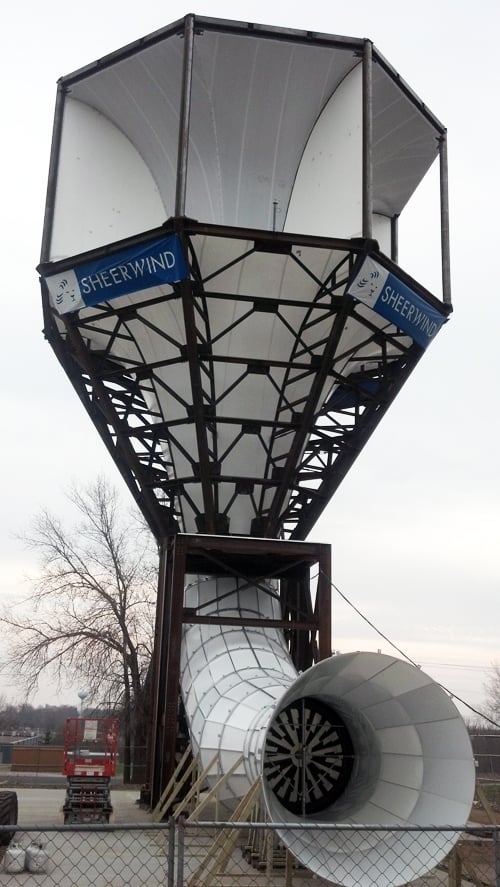Ducted Wind Turbines: An Energy Game Changer?
When it comes to wind power, unconventional schemes to boost power and cut costs have never been wanting. Quiet Revolution offers a vertical axis turbine that looks more like a blender than a power generation device. WhalePower proposes mimicking on turbine blades the tubercles found on whale fins to increase power production. Meanwhile Altaeros Energies is developing a flying donut to harness increased wind speeds found at higher elevations.

Earlier this month SheerWind, a wind power startup based in Chaska, Minnesota, added a new design, INVELOX, to the list. INVELOX, short for “increasing the velocity of wind” is a ducted turbine that looks a bit like a giant funnel sitting on top of an equally large periscope. The ductwork is designed to capture wind from any direction, increase its speed and concentrate the moving airflow before passing it through a relatively small turbine at ground level.
It’s an interesting concept that attempts to address a number of challenges facing conventional wind turbines. The power produced by a wind turbine increases with the cube of the wind speed so any increase in speed could offer a significant power boost. Increasing wind speed also reduces the cut in speed, or the minimum wind speed required to begin generating power. SheerWind officials say that by speeding up the wind they can boost power output by 280 percent and reduce the cut in speed by 80 percent to a wind speed of 2 miles per hour.
Another key advantage touted by SheerWind is smaller, ground-based turbines. A growing challenge for conventional wind turbine developers is the ability to build, transport, and mount giant turbine blades. By funneling the wind down to a smaller diameter duct, SheerWind is able to use a turbine with blades that are 80 percent smaller than those used in conventional turbines with similar output. Keeping the turbine at ground level will also significantly reduce installation and maintenance costs. All told, INVELOX should generate power for roughly one third less cost than conventional wind turbines, company officials say.
All of this sounds great but can INVELOX deliver? Researchers at The City College of New York have done fluid dynamics modeling of INVELOX and say the company’s claims stand up. (The researchers, mechanical engineers Yiannis Andreopoulos and Ali Sadegh and are listed as “technical advisors” by SheerWind but say they have not received compensation from the company for their analyses)
Martin Hansen, a wind energy expert at the Technical University of Denmark, disagrees. He says INVELOX will draw in and speed up the wind as claimed, but when the turbine is placed inside the ductwork it will create such high pressure that little additional air will be drawn into the device, making it a poor alternative to conventional turbine designs.
SheerWind completed it’s first large scale prototype earlier this month. CEO Daryoush Allaei says initial testing without the turbine resulted in a near doubling of wind speed passing through the device as predicted in prior modeling. Allaei says they will now install the turbine and begin monitoring power output.
Keep Reading
Most Popular
Large language models can do jaw-dropping things. But nobody knows exactly why.
And that's a problem. Figuring it out is one of the biggest scientific puzzles of our time and a crucial step towards controlling more powerful future models.
The problem with plug-in hybrids? Their drivers.
Plug-in hybrids are often sold as a transition to EVs, but new data from Europe shows we’re still underestimating the emissions they produce.
How scientists traced a mysterious covid case back to six toilets
When wastewater surveillance turns into a hunt for a single infected individual, the ethics get tricky.
Google DeepMind’s new generative model makes Super Mario–like games from scratch
Genie learns how to control games by watching hours and hours of video. It could help train next-gen robots too.
Stay connected
Get the latest updates from
MIT Technology Review
Discover special offers, top stories, upcoming events, and more.